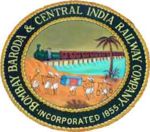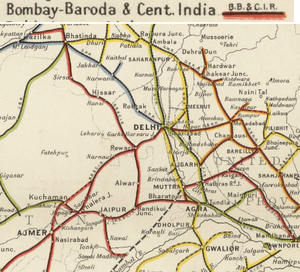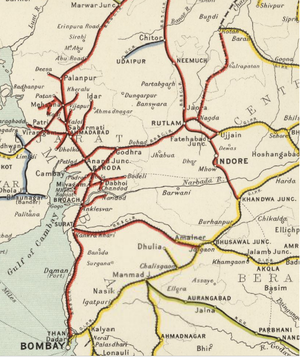Bombay, Baroda and Central India Railway
| Bombay, Baroda and Central India Railway | ||
|---|---|---|
 Churchgate Terminus & Offices, BBCIR, Bombay | ||
| Line of route | ||
| Bombay to Viramgam | ||
| Gauge / mileage | ||
| Broad gauge | 504 miles (1905) | |
| Timeline | ||
| 1855 | Formed as Guaranteed company | |
| 1905 | Line acquired by State | |
| Key locations | ||
| Presidency | Bombay | |
| Stations | Ahmedabad, Baroda, Broach, Surat | |
| System agency | ||
| 1906 | Worked by reformed BBCIR | |
| How to interpret this infobox | ||
| Bombay, Baroda and Central India Railway | ||
|---|---|---|
 Bombay, Baroda & Central India Railway device | ||
| System timeline | ||
| 1906 | BBCIR contracted to work State line | |
| 1942 | Working of system taken over by State | |
| Constituent companies / lines | ||
| Ahmedabad-Dholka Railway | ||
| Ahmedabad-Parantij Railway | ||
| Gaekwar's Dabhoi Railway | ||
| Gaekwar's Mehsana Railway | ||
| Godhra-Rutlam-Nagda Railway | ||
| Nagda-Ujjain Railway | ||
| Palanpur-Deesa Railway | ||
| Petlad-Cambay Railway | ||
| Rajpipla Railway | ||
| Rajputana-Malwa Railway | ||
| Tapti Valley Railway | ||
| Vijapur-Kalol-Kadi Railway | ||
| Key locations | ||
| Headquarters | Bombay (BG), Ajmer (MG) | |
| Workshops | Parel (BG), Ajmer (MG) | |
| Major Stations | Agra, Ajmer, Ahmedabad, Baroda, Cawnpore, Delhi, Indore, Jaipur, Rutlam, Surat | |
| Successor system / organisation | ||
| 1951 | Western Railway (IR zone) | |
| System mileage | ||
| Broad gauge | 868 miles (1905) 1233 miles (1943) | |
| Metre gauge | 2022 miles (1905) 1985 miles (1943) | |
| 2'6" NG | 132 miles (1905) 152 miles (1943) | |
| Associated auxiliary force | ||
| Bombay, Baroda and Central India Railway Regiment | ||
| How to interpret this infobox | ||
The Bombay, Baroda and Central India Railway Company (BB&CIR) was incorporated in 1855 for "the construction and working of a line from Bombay, via Surat and Baroda, to Ahmedabad - total about 320 miles. Capital 2,300,000l. Rate of Interest Guaranteed - 5 per cent on 2,000,000l. capital and 4½ per cent . on 300,000l. debentures." [1]
Contents
History
In 1852 John Pitt Kennedy was introduced in London to Lieutenant-Colonel French, who had been Acting Resident at the Court of the Guicowar of Baroda. Colonel French wanted to get up a company to construct a line of railway from Baroda to Tankaria Bunda, in the gulf of Cambay, a distance of about 45 miles. Colonel Kennedy joined him, but instead of the original line proposed, they projected what became the Bombay, Baroda, and Central India railway [2].
Their object was to open the most effectual line from Bombay, through the central and north-western districts, to meet the railway in progress of construction from Calcutta to Delhi, together with all the branches that such a line could require. Upon the formation of the company, Colonel Kennedy was appointed consulting engineer and managing director. A staff of engineers was sent to Bombay, and during the cold season of 1853, comparative surveys, sufficient to lay a well-digested scheme before the Government, were made [2].
On the 3rd of November, 1854, the Governor-General, Lord Dalhousie, sanctioned Broach, and Baroda, to Ahmedabad, leaving the remainder of the scheme for future decision, and the work to be commenced at Bombay. The Home Government, however, decided that the work should be commenced at Surat [2].
Construction commenced in 1855 and began work on track from Baroda to Surat. By 1865, the Bombay-Surat-Baroda-Ahmedabad route was complete; in 1867, the Virar -Bombay Backbay suburban service commenced with one train in each direction each day. In 1871, trackage was 300 miles (480km).
On 31 December 1905, ownership of the BB&CIR passed to the Government of India GoI and a new company formed to manage the BB&CIR under a contract agreed in 1907 and revised in 1913. [3] [4]
Management of the BB&CIR passed to the GoI on 1 January 1942.
In 1951, the BB&CIR (less the Delhi-Rewari-Fazilka and Kanpur-Achnera sections) merged with the Saurashtra, Jaipur State, Jodhpur (Marwar-Phulad section), Rajasthan and Cutch State railways to become the Western Railway, a zone of Indian Railways.
Branch Lines and extensions
- Ahmedabad-Dholka Railway; opened 1902. A metre gauge branch of BB&CIR.
- Dholka-Dhandhuka Railway; opened 1922 as an extension to the above.
- Ahmedabad-Parantij Railway; opened 1897. A metre gauge branch of BB&CIR.
- Godhra-Ratlam-Nagda Railway; first section opened 1897. A broad gauge(BG) line. Initially worked by, and finally merged into BB&CIR.
- Mathura-Hathras Provincial Railway; opened 1875. Section of BB&CIR network
Railways absorbed into BB&CIR
- Gujarat Railway Company - formed 1911. Owned and managed 3 lines Champaner-Shivrajpur- Pani Light Railway; Godhra-Lunavada Railway; Nadiad-Kapadvanj Railway; all worked by BB&CIR and taken over 1922
- Jaipur State Railway. Two State Railway branch lines (Jaipur-Sawai Madhopu, 1907 and Jaipur-Shaikhawati, 1916); worked by BB&CIR and merged 1900 into BB&CIR
- Rajputana-Malwa Railway; formed from Rajputana State, Holkar, Scindia-Nimach and Neemuch Nasirabad Railways; worked then merged into BB&CIR(qv), 1900
Lines worked by BB&CIR at some time
- Baria State Railway; opened 1892. Independent Princely State railway; later renamed Baria-Piplod State Railway, worked by BB&CIR
- Bilimora-Kalamba State Railway; opened 1914-15. State line worked by BB&CIR
- Bodeli-Chhota Udaipur Railway; opened 1917-18. State lineworked by BB&CIR
- Broach-Jambusar Railway; opened 1914-15
- Gaekwar's Baroda State Railway (GBSR); Narrow Gauge network expanded from 1863 to 1929; initially worked by BB&CIR until 1924 own agency.
- Gaekwar's Mehsana Railway; opened 1891; initially worked by BB○ from 1921 by GBSR
- Gaekwar's Petlad Railway; opened 1890. Initially worked by BB○ later by GBSR
- Kosamba-Zankhvav Railway; opened 1912. Constructed and worked by GBSR and later BB&CIR
- Mehsana-Vadnager Railway; opened 1907. Worked by BB&CIR
- Nagda-Mathura(Muttra) Railway; opened 1909. State line, worked by BB&CIR
- Nagda-Ujjain Railway; opened 1896. State line, worked by BB&CIR
- Palanpur-Deesa Railway; opened 1878>. Construction commenced 1878; worked by BB&CIR
- Patri Railway; opened 1873. Worked by BB&CIR
- Petlad-Cambay Railway; In service 1901, worked by BB&CIR
- Petlad-Vaso Railway; opened 1914-15. State line, worked by BB&CIR
- Piplod-Devgad-Baria Railway; opened c.1892. Independant Princely State Rly; later extended as Baria State Railway(qv), worked by BB&CIR
- Rajpipla State Railway; Princely State Railways (Anklesvar -Rajpipla Railway, 1897; Jhagadia-Netrand Railway> 1915) worked by BB&CIR
- Ratlam-Nagda Railway; opened 1896. Extension to Tapti Valley Railway; worked by BB&CIR
- Rewari-Ferozepore Railway ; Under construction 1882, worked by BB&CIR
- Tarapur-Cambay State Railway; opened <1908. Branch line worked by BB&CIR
- Tapti Valley Railway; Company formed 1896; opened 1898; worked by BB&CIR from 1899. Extended 1901, and named Surat-Amalner Railway.
- Vijapur-Kalol-Kadi Railway; opened 1902; owned by Baroda State; worked by BB&CIR
Records
Refer to FIBIS Fact File #4: “Research sources for Indian Railways, 1845-1947” - available from the Fibis shop. This Fact File contains invaluable advice on 'Researching ancestors in the UK records of Indian Railways' with particular reference to the India Office Records (IOR) held at the British Library
An on-line search of the IOR records relating to this railway [5] gives a large number of references. The most important being:-
- L /AG/46/6 “Records of the Bombay, Baroda and Central India Railway Company; 1856-1947”
Personnel Records
Unfortunately, there are no BB&CIR staff records held in the India Office Records at the British Library.
The only records that have been found :-
- E Sydney Luard was the Chief Locomotive, Carriage and Wagon Superintendent for BB&CIR, Bombay Control of Locomotive and Carriage Department, BB&CIR; redesigned and rebuilt those workshops; redesigned the rolling stock [6]. In 1892 represented BB&CIR at the Indian Railway Conference Association, Lahore. 'Locomotive Superintendents Conference' [7].
- James Robert Tickell was posted from State Railways to BB&CIR , from 1885 on loan as Assistant Engineer; Executive Engineer, 1893 and still in post 1905 [8].
- Frederick James Page,1909, BB&CIR, Assistant Locomotive Superintendent. He held various responsible positions with BB&CIR for nearly twenty-five years, and was concerned with the electrification of the Bombay suburban lines [9].
Stations
Bombay
- Grant Road
- Marine Lines
- Church Gate
- Kolaba
Historical books online
- Through Rajputana to Delhi : An Ilustrated Guide to the Districts Reached by the Bombay, Baroda and Central India Railway by Carlton Stubbs 1907 Archive.org
- Bombay Baroda Central India Railway Company 1920 Pdf download, Digital Library of India
- Bombay Baroda Central India Railway Company 1921 Pdf download, Digital Library of India
References
- ↑ "Money Market and City Intelligence", The Times, Wednesday, 15 June 1859, #23333, 7a.
- ↑ 2.0 2.1 2.2 Grace's Guide "John Pitt Kennedy"Retrieved on 21 Apr 2016
- ↑ " Administration Report on the Railways in India – corrected up to 31st March 1918"; Superintendent of Government Printing, Calcutta; page 12-22; Retrieved 17 Dec 2015
- ↑ H.M. Government “Statute Law Repeals: Nineteenth Report : Draft Statute Law (Repeals) Bill; April 2012"; page 118-120, paragraph 3.18-3.25 Retrieved on 2 January 2016
- ↑ “British Library Archives and Manuscripts Catalogue” - Search"; Retrieved 21 Jan 2016
- ↑ Grace's Guide "Who's Who in Engineering 1922 Name L"; Retrieved 26 Jul 2016
- ↑ The Locomotive Magazine and Railway Carriage and Wagon Review "Indian locomotive superintendents of the nineties", Volume 31, Number 393, 15 May 1925, page 133+ plate; Retrieved 26 Jul 2016
- ↑ Google Books "India List and India Office List, 1905" page 630 (pdf page 593) Retrieved on 18 Jul 2016
- ↑ Grace's Guide "Frederick James Page"; Retrieved on 18 Jul 2016

